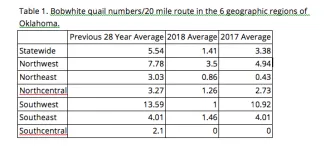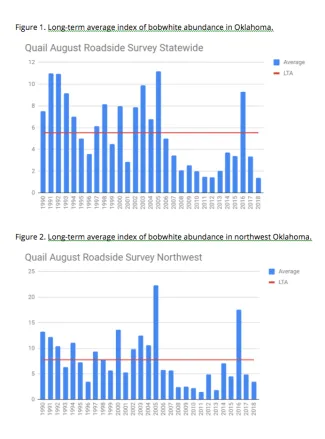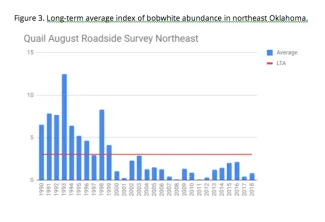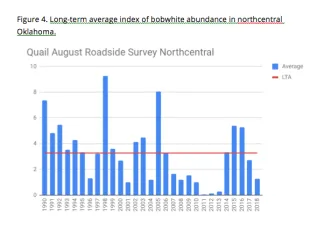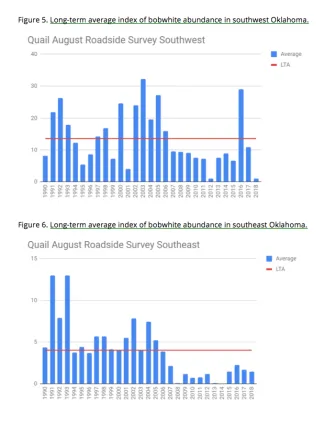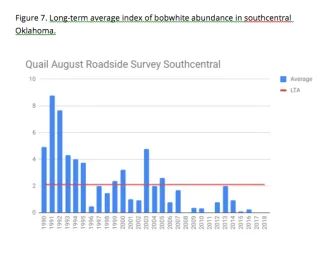August 2018 Quail Roadside Survey compiled by Allan Janus, Research Supervisor
The Oklahoma Department of Wildlife Conservation has conducted annual roadside surveys in August and October since 1990 to index quail populations across Oklahoma. The survey provides an index of annual population fluctuations.
Observers report the number of quail observed to provide an index of quail abundance (number of quail seen per 20 mile route) and indicate reproductive success. Currently, ODWC employees survey 83 20-mile routes in 75 of Oklahoma’s 77 counties. Oklahoma and Tulsa counties are excluded due to the amount of urbanization in those counties. Larger counties including Beaver, Ellis, Le Flore, McCurtain, Osage, Pittsburg, Pushmataha, and Roger Mills have two routes per county.
The 2018 August roadside quail survey shows the statewide Northern bobwhite quail (Colinus virginianus) index is 74.5 percent below the 28-year historic average (Table 1) (Figure 1). A large portion of the decline may have stemmed from the significant drought conditions southwestern Oklahoma experienced this summer.
Additionally, while rain did come to the Panhandle, it did not occur in time to help bobwhites that initiated nests in early June. Also contributing to the decline could be observation error caused by the unseasonably thick vegetation across the state due to wet conditions that have occurred since late June. Peak production seemed to occur later (perhaps as late as August) this year than normal (mid-June), and could be playing a part in a low August survey. When compared to the August 2017 survey of 3.38 bobwhites/20-mile route, the August 2018 survey average is 57.3 percent reduced, or 1.41 bobwhites/20-mile route (Table 1). The potential glimmer of hope is that juvenile bobwhites were observed in 55 percent of the samples compared to full-grown quail making up the other 45 percent. This suggests that the birds that did hatch may have had high survival.
Scaled quail (Callipepla squamata) were up in the few counties that they occur in Oklahoma — from four total scaled quail observed in August 2017 to 11 total scaled quail observed in August 2018. There are only a few routes in Oklahoma with the opportunity to observe scaled quail. Therefore, this is not a true prediction of scaled quail abundance, but rather a random observation.
All six geographical regions of Oklahoma declined from the August 2017 roadside survey. Most regions were similar to the statewide difference, with the exception of southwestern Oklahoma, which declined significantly due to drought conditions. All regions are currently below their historic 28-year average across the state. Look for our October roadside survey report, which will provide a better indication of what the upcoming quail hunting season could have in store.
